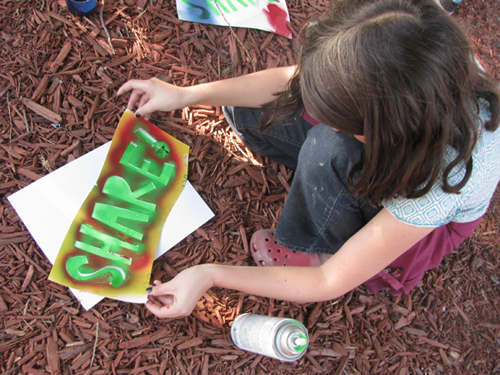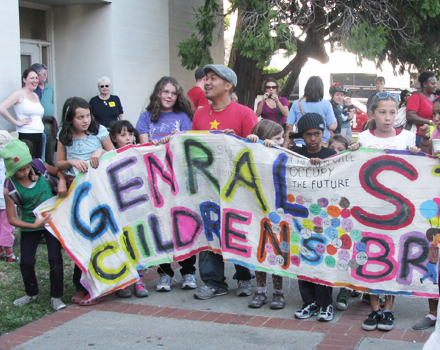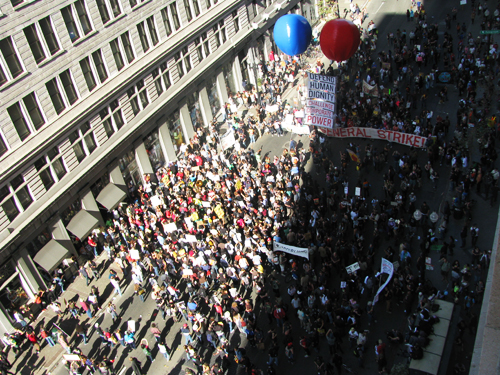Source: Climate Connections
 After the day of mass action in Oakland on Wednesday, November 2nd, when anywhere between 10,000 and 50,000 people hit the streets to demand economic justice by shuttering the big banks and blockading the nation’s fifth largest port, the media, not surprisingly, was focusing on the so-called ‘violence’ that broke out late that night and into the wee hours. November 3rd’s Oakland Tribune carried the headline “Violence, Vandals Divide a Movement. Day after: City Wakes to ‘disaster’ after peaceful, historic march. Occupy infighting: Protester says fringe groups hijacked message.”
After the day of mass action in Oakland on Wednesday, November 2nd, when anywhere between 10,000 and 50,000 people hit the streets to demand economic justice by shuttering the big banks and blockading the nation’s fifth largest port, the media, not surprisingly, was focusing on the so-called ‘violence’ that broke out late that night and into the wee hours. November 3rd’s Oakland Tribune carried the headline “Violence, Vandals Divide a Movement. Day after: City Wakes to ‘disaster’ after peaceful, historic march. Occupy infighting: Protester says fringe groups hijacked message.”
As an Oakland resident and a participant in the day’s events, I would like to contribute a bit of effort toward reading through the media fog.
Most importantly, I believe, this is not a DIVIDED movement, but a DIVERSE movement – one with many perspectives, tactics, and ways of promoting social change; until the media steps in to amplify the wrong narrative, it is not a question of a ‘hijacked message’, but of a lively, heated, and ongoing discussion and debate. Further, a few instances of property damage hardly qualify as ‘disaster.’ We have seen disasters, and we will see more, and, no, Virginia, a handful of dumpsters on fire in the street do not a disaster make. They may turn people off, they may diminish popular support and lead to severe finger-wagging – it may even be a bad tactic – but to label such incident a ‘disaster’ is to seriously misinterpret the scale of the larger crisis we are confronting.
As for the substance of the day’s events: This was the first General Strike in Oakland since 1946, and by all accounts, a tremendous success. November 2, 2011 will go down in history as one of the largest mobilizations ever in the SF Bay Area, and the largest protest since the Vietnam War. Some 50,000 people participated in the mobilizations throughout the day and night, shutting down every corporate bank in downtown Oakland and the Port. Marchers stayed strongly and clearly on message, calling for regulation, taxation and accountability from big banks, and demanding investment in schools, services, and housing.
 There was massive participation from teachers, public service workers, youth, and community organizations. There were two children’s marches, and activities at Occupy Oakland’s kids tent all day, with signs and themes like “Don’t you dare steal my future!” and “Occupy our Future.” I was there with my three-year old daughter, and many of her friends; a lot of sidewalk chalk was expended, a lot of parental advice was passed around – how do you talk to your five-year old about police in riot gear? – and a great time was had by all.
There was massive participation from teachers, public service workers, youth, and community organizations. There were two children’s marches, and activities at Occupy Oakland’s kids tent all day, with signs and themes like “Don’t you dare steal my future!” and “Occupy our Future.” I was there with my three-year old daughter, and many of her friends; a lot of sidewalk chalk was expended, a lot of parental advice was passed around – how do you talk to your five-year old about police in riot gear? – and a great time was had by all.
At least three corporate banks were subject to “foreclosure” inspired and led by black and Latino families fighting to save their homes. In response to a previous community march, Chase Bank postponed the sale of the home of one Oakland homeowner who gave her name as Brenda. Others in the crowd announced that they had re-occupied their homes in response to the wave of growing support for community justice. We expect home takeovers to continue all over the Bay Area as the movement continues to grow. It has been pointed out that this is the logical next step of the occupy movement – not to simply occupy public spaces, but to reclaim the properties that have been taken by the banks, most of which remain vacant while their former owners and tenants are in the street.
It is appropriate that Oakland and the San Francisco Bay Area are now the epicenter of resistance to the 1%. It is appropriate not only because of the long history of radical movements here, but because California is home to more billionaires per capita than any other state, and half of them live in the Bay Area. Many people here are painfully aware that the problem is not a lack of wealth, but the distribution of wealth. No one can testify better to this than the homeless families living at Oscar Grant plaza.
As far as charges of violence and divisive tactics go, let it be said that, for those of us who have observed social movement history in the U.S., it would come as a great surprise if the vandalism and destruction that occurred in the early hours of Thursday morning were not led by police provocateurs. There is a long and ignoble history of police masquerading as balaclava-clad ‘anarchists’ – and even taking leadership within movement spaces – in order to discredit and divide. There is no reason to believe that this is not the case here.
 Yet, even if it is the case, hundreds of people came to downtown Oakland the day after with trash bags, brooms, and dustpans, to clean and care for Occupy Oakland and the streets around. Hundreds more attended a City Council meeting to push a resolution in support of Occupy. This is what we call “civic engagement;” thanks to the radical tactics of some, such civic engagement has reached an all-time high.
Yet, even if it is the case, hundreds of people came to downtown Oakland the day after with trash bags, brooms, and dustpans, to clean and care for Occupy Oakland and the streets around. Hundreds more attended a City Council meeting to push a resolution in support of Occupy. This is what we call “civic engagement;” thanks to the radical tactics of some, such civic engagement has reached an all-time high.
For those who insist on talking about windows that were broken by angry protesters, let’s not forget that there are too many neighborhoods in Oakland with broken windows due to neglect, foreclosure, and systemic violence. If we are going to wring our hands over property destruction and broken windows, lets at least be honest, and consider all the windows that have been broken by the banks since the beginning of the foreclosure crisis – and, indeed, all the families that have been destroyed by the economic crisis, and the ongoing crisis of capital concentration.
Let’s recall, too, that the Oakland Police Department (OPD) continues to use tear gas on non-violent protesters, even as Scott Olsen remains in the hospital, unable to speak because of brain damage caused by an OPD tear gas canister. The OPD claimed that they used teargas in ‘self-defense’; tear-gas is not self-defense, it is crowd-control.
That Police continue to use tear gas canisters after causing a life threatening injury with one is an outrage. Yet, in the wake of the Oscar Grant killing two years ago and endless accounts of police corruption and abuse, it as an outrage to which Oaklanders are all-too accustomed.
The simple fact is, this is a social movement made up of a vast majority of the population who are righteously and reasonably angry, and it’s bound to get messy. One could easily parrot the words of Donald Rumsfeld and James Wolfensohn and other mass murderers, and say “In order to make an omelet, you have to break a few eggs.” But, that’s a stupid metaphor, because it avoids taking on the real violence caused by war and economic injustice. The point, though, is that the Occupy movement cannot be expected to be neat, orderly, and pretty, because real social change is never near, orderly, and pretty. Tragic as it is, the crisis we have been saddled with isn’t pretty, and the way out – any way out – won’t be pretty either.
The fact is, America, this is what a popular uprising looks like. Get used to it.
***
Jeff Conant is the author of A Poetics of Resistance: the Revolutionary Public Relations of the Zapatista Insurgency (AK Press, 2010) and A Community Guide to Environmental Health (Hesperian, 2008), and lives in Oakland, California, where he works as Communications Director for Global Justice Ecology Project.
